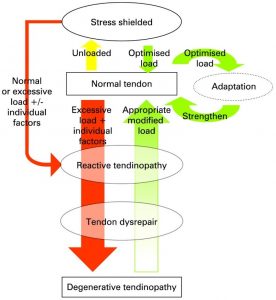What is a tendinopathy?
Written by Matthew Azzopardi AEP (Accredited Exercise Physiologist)
Let’s start with the basics. Tendons connect muscle to bone and are important in transferring forces to assist movement.
Tendinopathy is a condition often caused by repetitive overloading of the tendon over a prolonged period of time. It encompasses several changes in the tendon tissue fibre, such as size and cell/matrix structure changes, including a change in collagen fibre type from type I to type III, a less elastic collagen with reduced ability to transmit forces.
Tendinopathies commonly occur in the Achilles tendon, patella tendon and tendons of the elbow (Have you ever heard the terms, tennis elbow & golfer’s elbow?), gluteal, although they can occur elsewhere.
Let’s take a simplified look at a tendon during different stages of tendinopathy in figure 1. You’ll notice the tendon structure changes over time from a well organised, healthy tissue (A); to a wavy, curvy, disorganised, thicker structure (B & C); as the tendon progresses down the different stages of tendinopathy. This results in a decreased elasticity of the tissue. The longer the tendon experiences inappropriate stressors, the greater the risk of progressing down the different stages. Unfortunately, avoiding use of the tendon over a prolonged period of time or ‘stress-shielding’ the tendon can also result in dysfunction (see figure 2).

Until recently the terms tendinopathy & tendinitis were used interchangeably. We now know that they are different, as current research strongly suggests that there is much less, or even minimal to no inflammation involved in tendinopathy. Instead, small, micro-tears within the tendon lead to dysfunction & leave tendons susceptible to rupture, once a tendon becomes degenerative it creates a vastly increased risk of tendon rupture.
What is the treatment for tendinopathy?
Scientific research in this area is constantly advancing, with load management emerging as the gold standard method of treating tendinopathies.
Traditional treatment including non-steroidal anti-inflammatory (NSAID) medication and corticosteroid injections are seen now to be less effective long term management strategies than previously thought, with growing evidence that load management is the most influential and effective strategy for the long term treatment and management of tendinopathies.
What is load management?
Ideally, a health professional will take a holistic approach to assess how you are loading the tendon in your everyday life & investigate the cause, and contributing factors, of the dysfunction. Then we can aim to optimise the loading levels on the tendon, gradually strengthening the area, re-aligning tissue fibres, altering tissue type and potentially reducing pain to therefore help you return to your activities of daily living & be better equipped to manage your tendons.
Strategies include:
- Resting short term to unload the tendon and gradually re-introduce appropriate loading of the tendon.
- Altering the movement technique of a particular overstressing activity or movement, to evade overloading the tendon.
- Isometric exercises (loading with sustained fibre length) are a great place to start. Progressing to eccentric exercises (lengthening tissue fibre under load) are recommended in a number of research articles, with ongoing study in this area being conducted.
- Be patient. Try not to fall into the trap of going from ‘zero to hero’. Give your tendons time to adapt. They’ll thank you for it in the long run. Prevention is also very important, particularly if you are susceptible to tendon injuries. Aim to avoid sudden increases in frequency, intensity or duration of an activity. Also, aim to allow adequate recovery periods between physical activities.

It is important to seek appropriate treatment from an Accredited Exercise Physiologist, Myotherapist or Physiotherapist. Injury management often requires a multi-disciplinary team effort. Special thanks to Physiotherapists Andrew Wynd and his colleagues Nick Rees and Anne-Marie Montgomery from the Balwyn Sports & Physiotherapy Centre, who recently held a professional development seminar, sharing their insights on tendinopathy and discussing ideas around the topic with the team at Inspire Fitness for Wellbeing, a collaboration ultimately to lead to improved client care.
